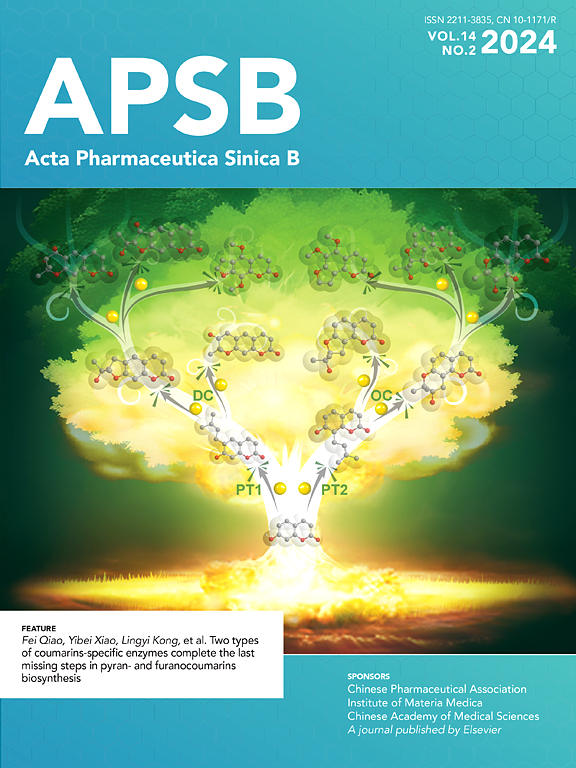Remodeling tumor immunosuppressive microenvironment through dual activation of immunogenic panoptosis and ferroptosis by H2S-amplified nanoformulation to enhance cancer immunotherapy
IF 14.7
1区 医学
Q1 PHARMACOLOGY & PHARMACY
引用次数: 0
Abstract
The deficiency in immunogenicity and the presence of immunosuppression within the tumor microenvironment significantly hindered the efficacy of immunotherapy. Consequently, a nanoformulation containing metal sulfide of FeS and GSDMD plasmid (NPFeS/GD) had been developed to effectively augment antitumor immune responses through dual activation of immunogenic PANoptosis and ferroptosis, as well as reprogramming immunosuppressive effects via H2S amplification. The bioactive NPFeS/GD exhibited controlled release of GSDMD plasmid, H2S, and Fe2+ in response to the tumor microenvironment. Fe2+, H2S, and the expression of GSDMD protein could effectively elicit highly immunogenic PANoptosis and ferroptosis. Furthermore, releasing H2S could mitigate the overexpression of indoleamine 2,3-dioxygenase1 (IDO1) induced by immunogenic PANoptotic and ferroptotic cell death and disrupt the activity of IDO1. Consequently, NPFeS/GD effectively triggered the antitumor innate and adaptive immune responses through induction of PANoptotic and ferroptotic cell death and reshaped the tumor immunosuppressive microenvironment to enhance antitumor immunotherapy for metastasis inhibition. This study unveiled the significant potential of immunogenic PANoptosis and ferroptosis in H2S gas therapy for enhancing tumor immunotherapy, offering novel insights and ideas for the rational design of nanomedicine to enhance tumor immunogenicity while reprogramming the tumor immunosuppressive microenvironment.

h2s扩增纳米制剂通过双激活免疫原性泛光和铁下垂重塑肿瘤免疫抑制微环境,增强肿瘤免疫治疗
免疫原性的不足和肿瘤微环境中免疫抑制的存在严重阻碍了免疫治疗的效果。因此,研究人员开发了一种含有金属硫化物的FeS和GSDMD质粒(NPFeS/GD)纳米制剂,通过双激活免疫原性PANoptosis和ferroptosis,以及通过H2S扩增重编程免疫抑制作用,有效增强抗肿瘤免疫应答。具有生物活性的NPFeS/GD在肿瘤微环境下表现出GSDMD质粒、H2S和Fe2+的可控释放。Fe2+、H2S和GSDMD蛋白的表达可有效引起高免疫原性PANoptosis和ferroptosis。此外,释放H2S可以减轻免疫原性泛光性和嗜铁性细胞死亡诱导的吲哚胺2,3-双氧合酶1 (IDO1)的过表达,并破坏IDO1的活性。因此,NPFeS/GD通过诱导PANoptotic和ferroptotic细胞死亡,有效触发抗肿瘤先天和适应性免疫应答,重塑肿瘤免疫抑制微环境,增强抗肿瘤免疫治疗以抑制转移。本研究揭示了免疫原性PANoptosis和ferroptosis在H2S气体治疗中增强肿瘤免疫治疗的巨大潜力,为合理设计纳米药物以增强肿瘤免疫原性同时重新编程肿瘤免疫抑制微环境提供了新的见解和思路。
本文章由计算机程序翻译,如有差异,请以英文原文为准。
求助全文
约1分钟内获得全文
求助全文
来源期刊

Acta Pharmaceutica Sinica. B
Pharmacology, Toxicology and Pharmaceutics-General Pharmacology, Toxicology and Pharmaceutics
CiteScore
22.40
自引率
5.50%
发文量
1051
审稿时长
19 weeks
期刊介绍:
The Journal of the Institute of Materia Medica, Chinese Academy of Medical Sciences, and the Chinese Pharmaceutical Association oversees the peer review process for Acta Pharmaceutica Sinica. B (APSB).
Published monthly in English, APSB is dedicated to disseminating significant original research articles, rapid communications, and high-quality reviews that highlight recent advances across various pharmaceutical sciences domains. These encompass pharmacology, pharmaceutics, medicinal chemistry, natural products, pharmacognosy, pharmaceutical analysis, and pharmacokinetics.
A part of the Acta Pharmaceutica Sinica series, established in 1953 and indexed in prominent databases like Chemical Abstracts, Index Medicus, SciFinder Scholar, Biological Abstracts, International Pharmaceutical Abstracts, Cambridge Scientific Abstracts, and Current Bibliography on Science and Technology, APSB is sponsored by the Institute of Materia Medica, Chinese Academy of Medical Sciences, and the Chinese Pharmaceutical Association. Its production and hosting are facilitated by Elsevier B.V. This collaborative effort ensures APSB's commitment to delivering valuable contributions to the pharmaceutical sciences community.
 求助内容:
求助内容: 应助结果提醒方式:
应助结果提醒方式:


